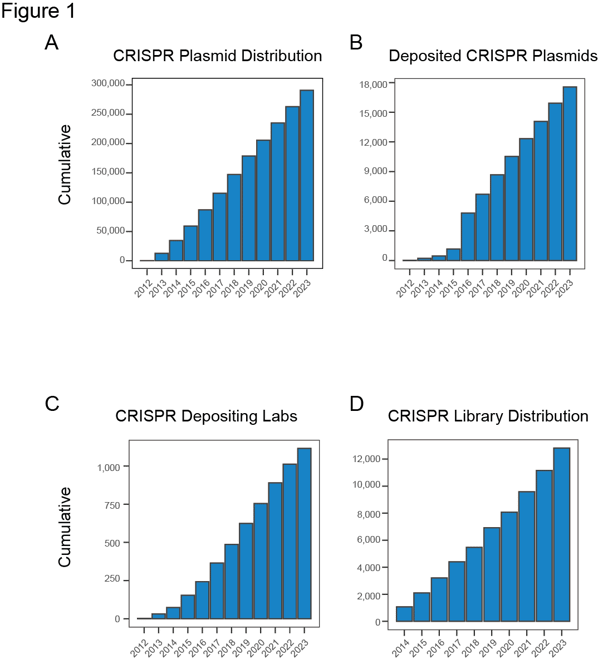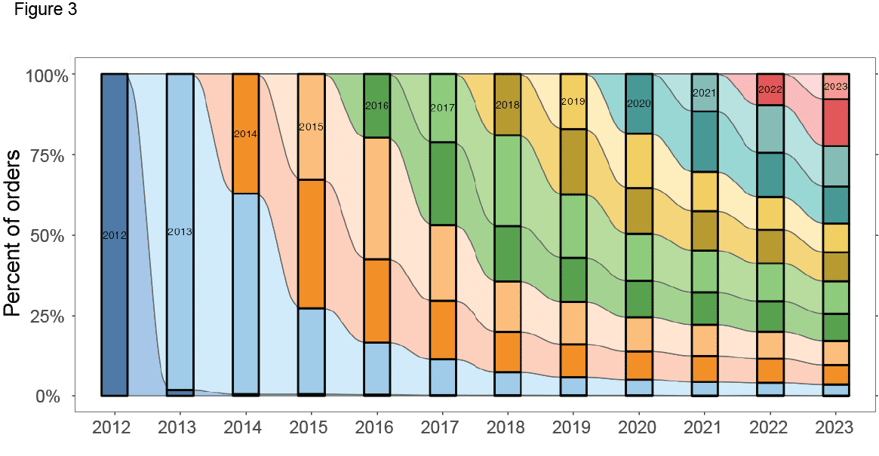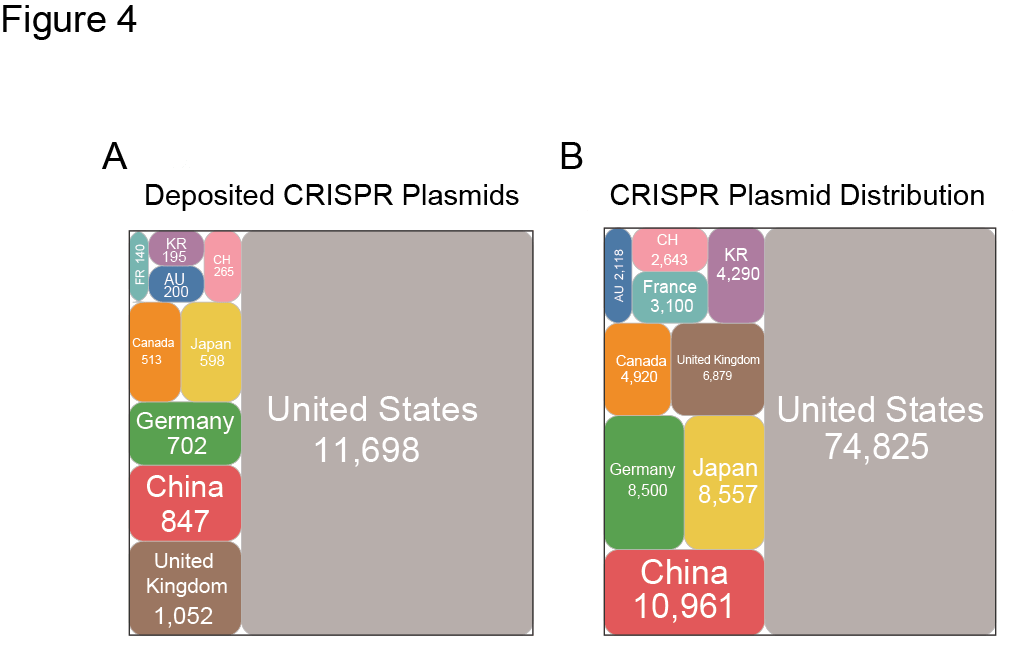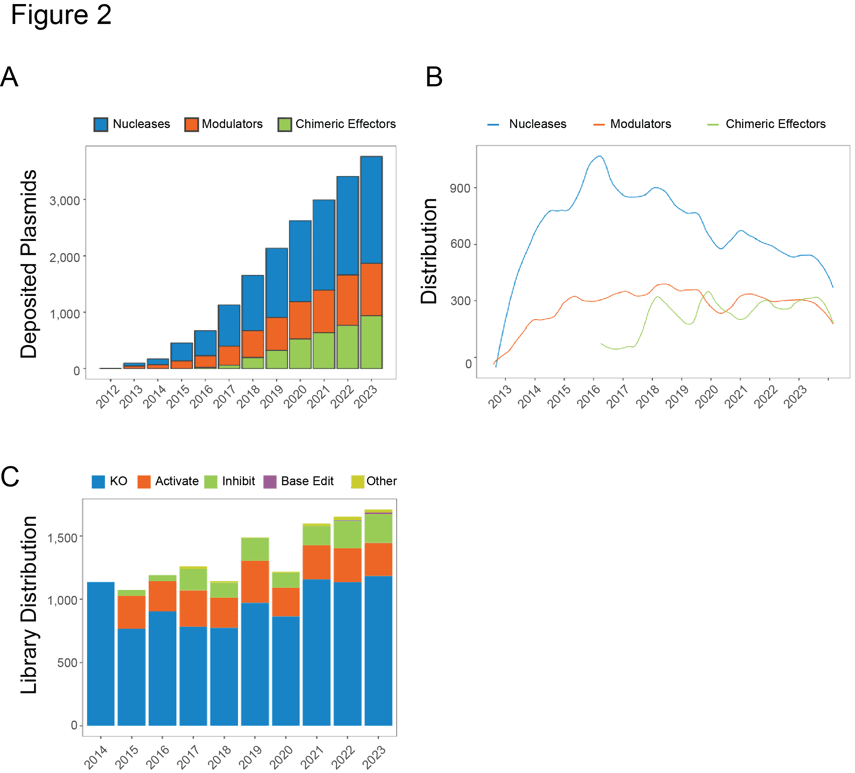As we celebrate twenty years at Addgene, we are sharing stories of our repository’s positive impact on science and scientists around the globe. Our first story focuses on a technology that has changed virtually all of biology…CRISPR.
Since the discovery of CRISPR, the labs that developed CRISPR tools were committed to sharing them with the rest of the community. They did this by depositing them in Addgene’s repository. Other researchers, eager to try this new technology, were quick to request CRISPR plasmids and, in turn, to develop tools of their own to share. Over the years, Addgene’s repository has grown to include many CRISPR tools.
Distributing and depositing
In Figure 1, you can see cumulative numbers of CRISPR plasmid distribution and deposits (Figures 1A and 1B); the cumulative number of labs who have deposited CRISPR plasmids (Figure 1C), and the cumulative number of CRISPR libraries Addgene has distributed (1C), from 2012 to 2023. Addgene’s collection of CRISPR tools has grown steadily, gaining approximately 2,000 plasmids/year from 2017 to 2023. This growth is supported by new labs joining the Addgene CRISPR community, with approximately 100 new CRISPR depositors each year.
 |
| Figure 1: Addgene CRISPR distribution and deposits. (A) Cumulative CRISPR plasmids shipped by year. (B) Cumulative CRISPR plasmids deposited with Addgene by year. (C) Cumulative number of laboratories that have deposited CRISPR plasmids by year. (D) Cumulative CRISPR pooled libraries shipped by year. |
As of the end of 2023, Addgene had almost 18,000 CRISPR plasmids in our repository, and we have shared almost 300,000 CRISPR plasmids and 12,000 CRISPR libraries (Figure 1D). That’s a lot of editing!
CRISPR functions in use
But exactly what kind of editing are people doing with all these CRISPR plasmids (and libraries)? We wanted to know, so we classified CRISPR plasmids containing a nuclease into three functional groups: nucleases, modulators, and chimeric effectors. Nucleases generate a classic double-stranded break, while modulators regulate transcription and chimeric efforts make a precise edit or insertion via a chemical modifier. We used these categories to see what kinds of CRISPR tools people were depositing and requesting each year (Figure 2). We did a similar analysis with CRISPR pooled libraries, although we used different categories (Figure 2C). Note that in Figure 2, the numbers on the X axis refer to distribution and deposits per year, rather than a cumulative total.
|
|
| Figure 2: Addgene CRISPR deposit and distribution by function and expression type. (A) Cumulative number of deposited CRISPR items, categorized by CRISPR function, by year. (B) Number of requests per month for each CRISPR function from 2012 to 2023; data are smoothed using locally estimated scatterplot smoothing. (C) Number of requests per year for pooled libraries, categorized by function, from 2014 to 2023. |
As you can see, nucleases, the original CRISPR tool, remain the most popular deposited and distributed CRISPR plasmids. But modulators and chimeric effectors, made available in 2013 and 2016, respectively, quickly became popular, and have maintained that popularity through the years.
Libraries are divided into different categories based on function: knockout (KO), activate, inhibit, base edit, and other. The first libraries deposited with Addgene were knockout libraries, and they remain the most popular with our requestors. However, we can again see quick adaptation and steady use of all types of libraries, once made available through the repository. And the number of plasmids and libraries deposited and requested grows steadily each year. (The dip in 2020 is likely due to the pandemic; for more discussion on that, see Pyhtila et al 2023.)
One of our favorite observations from this data is that CRISPR technology is consistently showing rapid development and quick adoption by the community. Our depositing labs continue to develop and share new tools, while our requesting labs continue to request and use new tools. Because there’s such rapid adoption, we thought that requests would be biased towards more recent deposits — but that’s not quite what the data said!
CRISPR is always in style
When we plotted CRISPR plasmids requested each year by year of deposit (Figure 3), we saw that once CRISPR plasmids become popular, they continue to be requested through the years, even as more CRISPR technologies become widely used and available. If we look closely at Figure 3, which shows requested CRISPR plasmids categorized by “age” or year they were deposited, you can see that from 2013 and on, popular CRISPR plasmids seem to never truly go out of style. Instead, an almost even mix of plasmids (by age) are requested and shipped out each year.

|
| Figure 3: Percentage of requests per year for CRISPR plasmids categorized by year of deposit. Outlines show a representative proportion of CRISPR plasmids requested, categorized by year of deposit, for each year from 2012 to 2023. |
What does this tell us? Well, it’s hard to draw any exact conclusions, but it certainly suggests that Addgene depositors make CRISPR tools that fill needs in the community. The rapid adoption of new tools, illustrated in Figure 2, and the longevity of tools seen in Figure 3, indicates that the usefulness of popular CRISPR tools is both enduring and rapidly recognized.
Where is the CRISPR community?
Addgene exists to help researchers share useful tools, and as such, we’re always looking to understand our community better. We therefore looked at depositors and requestors by country, and graphed the top ten countries for each group (Figure 4).
 |
| Figure 4: Addgene deposits and distribution by country. (A) Total CRISPR plasmids deposited by country; square size is proportional to number of plasmids deposited by each country. Countries shown are top 10 depositing countries. (B) Total CRISPR plasmids requested by country; square size is proportional to the number of plasmids requested by each country. Countries shown are the top 10 requesting countries. FR=France; KR=South Korea; CH=Switzerland; AU=Australia. |
It probably comes as no surprise that the USA is the largest depositor and requestor of CRISPR plasmids. But many other countries, from Japan to Australia, are significant depositors and requestors. CRISPR tools are developed and used all over the globe. As of 2023, we have CRISPR plasmids deposited from labs in ~40 different countries, and we’ve shipped CRISPR plasmids to labs in ~100 countries.
The impact
Addgene’s CRISPR collection contained 197 plasmids in 2013. A decade later, it had grown to 17,560 CRISPR plasmids. That’s almost a ninety-fold increase in size! From this collection, we’ve shared almost 300,000 plasmids with researchers all over the world. That’s an average of 27,272 plasmids distributed per year, or approximately 104 plasmids shipped per working day, including appropriate MTAs and customs forms.
Of course, ordering the plasmids is the easy part; using them can be a bit more challenging. Addgene’s free educational resources help scientists navigate that learning curve. As of 2023, our CRISPR guide has been viewed 1,904,462 times, and the CRISPR 101 eBook has been downloaded over 72,000 times. Our CRISPR blog posts are also frequently read: Homology Directed Repair has been viewed 219,289 times, while Validating Your Genome Edit has 76,011 views.
Has all of this work helped scientists use CRISPR technology? We think so — and so do our requestors! CRISPR plasmids in the Addgene repository have been cited a total of 23,006 times, including 14,677 unique citations.
CRISPR is a story that centers around the impact of science, but our data makes it clear that it’s also a story of community, cooperation, and sharing. Sharing this story is a truly special way to celebrate our twentieth anniversary in 2024, and it’s all because of our CRISPR depositors and requestors. Thank you!
Want to dive deeper into Addgene’s CRISPR data? Read our recent publication, “The Expanding Dissemination and Distribution Patterns of Diverse CRISPR Plasmids by Addgene,” in The CRISPR Journal (Pyhtila et al., 2023). Our thanks to Rodolphe Barrangou for his authorial contributions to, and support for, this and previous Addgene CRISPR publications.
References and resources
References
Pyhtila, B., Kasowitz, S., Leeson, R., & Barrangou, R. (2023). The Expanding Dissemination and Distribution Patterns of Diverse CRISPR Plasmids by Addgene. The CRISPR Journal, 6(6), 493–501. https://doi.org/10.1089/crispr.2023.0059.
More resources on the Addgene blog
Twenty Years of Sharing Science
Topics: CRISPR, Addgene News








Leave a Comment